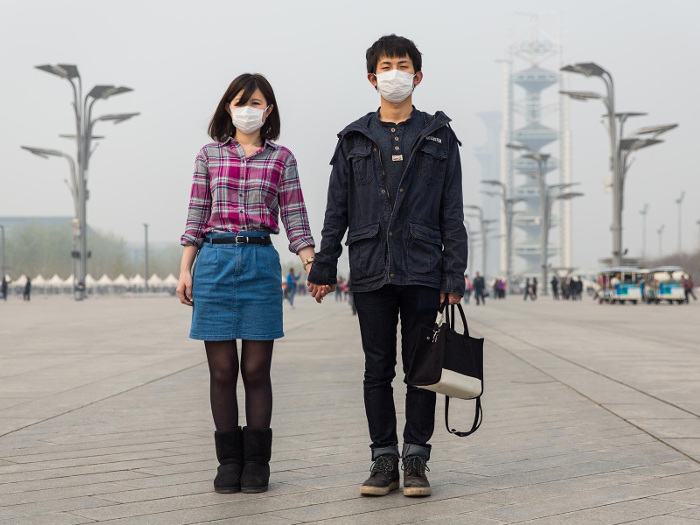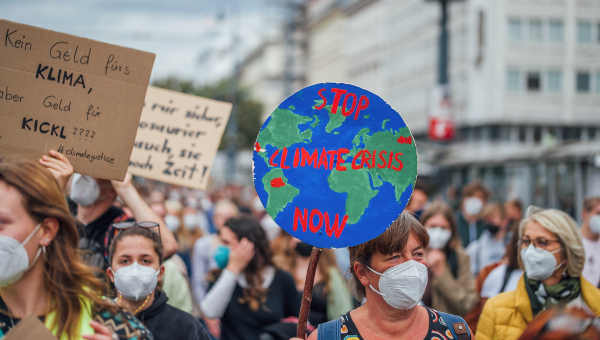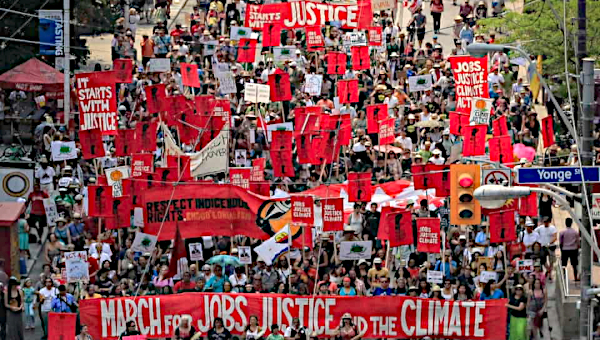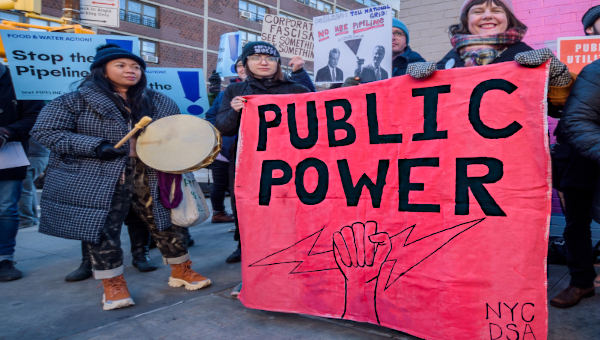Focus on China: The East is Green?
China’s rapid economic expansion is based on massive state investment, low pay and manufacturing for export to the Western economies at the same time as the promotion of domestic consumerism. Global competition for resources and markets means China must continue this economic model. But this brings with it the risk of war, economic crisis and the threat of workers fighting for an increased share of the enormous wealth being generated. But it is also driving environmental disaster on a local and international scale.

Last October Chinese President Xi Jinping outlined a five-year economic strategy. He focused on putting China at the centre of the world economy, offering “a new option for other countries and nations who want to speed up their development while preserving their independence.” But commentators noted how Xi also emphasised the environment, using the word 89 times in the 3-hour, 23-minute speech and pledging to lead globally on the environment.
In a dig at Donald Trump’s withdrawal of the United States from the Paris climate agreement, Xi argued that, “No country alone can address the many challenges facing mankind. No country can afford to retreat into self-isolation.” By contrast he claimed that China had “taken a driving seat in international cooperation to respond to climate change,” and echoing Friedrich Engels, concluded that, “Only by observing the laws of nature can mankind avoid costly blunders in its exploitation. Any harm we inflict on nature will eventually return to haunt us. This is a reality we have to face.”
Unprecedented Environmental Crisis
China faces an unprecedented environmental crisis. Mao Zedong’s decision to make China’s economy match and then overtake the West triggered numerous environmental problems. But the sheer scale of today’s economic expansion means that China’s environmental crises today are colossal.
China is the world’s leading polluter in absolute terms. The country is responsible for around 30 per cent of global carbon emissions, twice that of the next biggest polluter, the USA. In per capita terms, China’s emissions (7.9 tons per person) fall below those of many other industrialized countries such as the USA (16.4) or Germany (9.2). But this merely highlights the size of China’s population (1.4 billion). Meanwhile, current economic trends will only drive emissions upwards. In 2000 China’s per capita emissions were just 2.7 tons per person.
Structural Pollution
During the first decade of this century China’s emissions increased by about 10 per cent per year, though this has recently slowed to 3 per cent (even declining slightly in 2015/16). These changes reflect increased use of nuclear and renewable energies, as well as structural changes to manufacturing. However, this does not mean that China is heading toward a path of sustainable development. A study by the Global Carbon Project in November showed that rather than declining, 2017 is likely to see an increase in Chinese emissions, contributing to a new global record high.
One of the most visible aspects of Chinese environmental problems is air pollution. Chinese cities are blanketed by thick smog, and images of people wearing masks or respirators are common. Only 1 per cent of China’s urban population breathe air considered safe by European Union standards. The consequences are real with a million people dying every year in China as a result of air pollution. The fumes belching from thousands of factories and the exhausts of millions of cars are daily poisoning the air, while the destruction of vast areas of forest reduces the natural environment’s ability to absorb pollution.
Some cities have managed to reduce air pollution but this is often only through moving dirty industry away from urban areas. As with the air, so with the water. A September 2017 report by Greenpeace East Asia showed that millions of Chinese people use water that isn’t safe to drink. Even the wealthier cities suffer. According to Greenpeace, 85 per cent of the river water in Shanghai is unsafe and in Tianjin, a city of 15 million, the figure was 95 per cent. Almost half of China’s provinces have failed to meet water quality targets.
Water pollution is matched by shortages partly due to industrialization. Coal plants and mining consume billions of cubic metres of water, leading to shortages downstream. Huge projects to redirect rivers to bring water to population centres and agricultural areas mean more building and more industry. And building is another factor in China’s environmental crisis.
Between 2011 and 2013, according to the historian Vaclav Smil, China poured more concrete than the U.S. did in the entire 20th century. Concrete is hugely energy intensive to produce and also has consequences for the extraction of the materials used. China’s building boom (and consequent concrete usage) is partly driven by the massive urbanization that is taking place, but also the building required to feed industry.
The Three Gorges Dam across the Yangtze River provides 22,500 megawatts of energy, yet it is also an environmental disaster. Sixteen million cubic metres of concrete were used to build the dam, and up to 1.3 million people were displaced. The dam’s supporters claim that the energy produced is equivalent to burning 50 million tonnes of coal. But the impact on the environment and even local geology continues to be felt.
Downstream from the dam, farmers and villagers complain about the resulting lack of water and, somewhat ironically, earlier hydropower plants have stopped producing electricity due to water shortages. Journalist Jonathan Watts points out that China has over half of the world’s 45,000 biggest dams, and this method of water control contrasts to historic Chinese water regulation which involved allowing controlled flooding of land, which was less polluting and less destructive.
The construction of massive dams in developing nations such as India and China is frequently less about solving energy shortages or preventing flooding and more about the assertion of state power. Three Gorges and other dams can be closely linked to Mao’s determination to control nature in the interest of Chinese development.
Industrialized agriculture is also part of the problem. As China’s cities expand and population grows, there are fewer people working the land, and feeding the cities requires increasingly intensive food production. Sustainable food production is impossible as monocultural production, pesticides and artificial fertilizers are used in vast quantities to produce food.
Since Trump pulled the U.S. out of the Paris agreement plenty of commentators have turned to China as the only hope for radical action on climate change. A headline in the British Independent newspaper was typical: “Only China and India can save us now.” Much of this hope rests on the belief that technology can reduce emissions. So these commentators emphasise China’s massive investment in renewable energy schemes – it aims to get 20 per cent of its energy from renewables by 2030 – and the fact that China has recently cancelled the building of more than 100 coal plants in an effort to reduce pollution.
As noted earlier, Xi has made a commitment to the Paris agreement, saying in January 2017, “All signatories should stick to it instead of walking away from it, as this is a responsibility we must assume for future generations.”
But this hides the reality. First, China remains a fossil fuel economy. Despite the renewable boom and thousands of hydroelectric plants, about two-thirds of China’s energy comes from burning coal. In December 2016 the Shenhuya Coal-to-Liquid plant went online: this technology produces liquid fuels from coal through an expensive, water hungry and inefficient process that is only viable while coal prices are low and oil prices high.
The continued operation of these dirty plants is hardly a sign of a country abandoning fossil fuels on a massive scale. In addition, Chinese companies are building hundreds of coal-powered plants around the world. As a recent New York Times report noted, this means that China takes the profits but the carbon emissions and the pollution are the problem of countries such as Egypt, Vietnam and Iran. China is also experiencing a “fracking boom.” Using arguments familiar to UK environmentalists, Chinese authorities argue that fracking will allow it to reduce emissions and prices, while keeping the lights on.
Renewable
Second, Chinese renewable energy is tremendously inefficient. Author Richard Smith recently pointed out that:
“In 2015, China spent a record $102-billion on wind, solar, geothermal and other low- or no-carbon renewable energy. Yet in 2016 wind produced just 4 per cent and solar barely 1 per cent of China’s electricity. The reason why China produces so little renewable energy despite all the investment is that so much of China’s renewable energy is ‘curtailed’ [wasted]… Nationally, about 21 per cent of wind energy is curtailed, as much as 40 per cent in some provinces, even more than 60 per cent in Xinjiang, ironically, the province with the most installed wind power.”
In 2008 about a third of Chinese wind turbines were not even connected to the electricity grid. While it is likely that this has improved since, the problems of inefficient and unplanned industrial expansion will severely hamper any attempts to switch to renewable energy on a significant scale.
Ultimately, whether or not China can reduce emissions to sustainable levels and develop along a sustainable pathway will depend not on promises from its leaders, or technological solutions, but on challenges to its economic model.
Chinese pollution is closely linked to its strategy of manufacturing goods for export, a direction in which Chinese industry has been re-orientated since the 1990s. The strength of Chinese manufacturing and the decline of industry in the developed world has effectively meant that carbon emissions are relocated to China from Western economies.
In 2014 when China and the U.S. signed an agreement on climate change, one report by the UK based Carbon Brief website noted that in 2012 goods exported to the USA were responsible for 512 megatons of carbon dioxide, about 5 per cent of China’s total. Overall, in 2012, about 16 per cent of China’s emissions came from the manufacture of goods for export. The problem is made worse by the additional pollution produced when these goods are moved around the globe. Emissions from shipping and aircraft were notably excluded from the Paris Climate agreement and do not count toward agreed national targets.
Greatest
Although China is the world’s greatest polluter, its emissions are not just the result of rapid industrialization and the growth of consumer demand but are also produced by China’s role within a wider capitalist system. The country is also itself responsible for pollution abroad. It is heavily dependent on imports of key minerals and resources such as copper, iron ore and oil for its manufacturing. The foreign extraction of these effectively outsources Chinese emissions to other, often developing, countries. As we noted above in the case of the coal industry this means that Chinese state corporations make massive profits while other countries pay the environmental price.
In order to reduce its strategic dependence on imports China is hunting out new sources of minerals and fossil fuels within its own borders. As Gabriel Lafitte has shown in his recent book, Spoiling Tibet, Chinese authorities have identified Tibet as rich in deposits of gold, chromium, copper and other minerals and metals, as well as coal, natural gas and oil. Lafitte points out that China has become a monster in terms of the consumption of such materials – in 2012 it used “14.8 per cent of planetary resources.” Its continued industrial development requires that it find vast new sources of these materials.
In Tibet this has meant the degradation of huge areas of the landscape, the forced relocation of thousands of indigenous nomads, and the building of huge mines, factories and plants that often destroy local economies. Despite central government legislation to protect the environment, local businessmen frequently ignore the laws, or pay bribes to escape prosecution. Those who speak out often face repression.
Lafitte describes one protest against the development of a gold mine in the Kanlho prefectural capital, in the early 2000s. Initial protests won minimal compensation for locals but bribes to the police led to a crackdown and during one protest soldiers drove a vehicle into a crowd injuring three or four people. An eyewitness said the police threatened to shoot anyone else who protested and explained that “there is less rainfall and more drought now, the environment is badly polluted and that is what led people to protest on two occasions.”
The role of the police and the army in violently defending corporate interests against community and workers’ protests is well documented.
But despite this protests are not uncommon. Judith Shapiro, an academic and environmentalist who focuses on China, noted that in 2008, 127,000 “mass incidents” were recorded, of which about 5,000 concerned environmental issues. These varied from protests against the building of mines or factories, to demonstrations against pollution, lack of water, and air-quality. The persecution and imprisonment of protesters, journalists and NGO activists who highlight environmental and labour issues is common. Shapiro comments that “China’s new middle class now demands clean air and water even as its material desires spell trouble for the environment.”
She also points out that despite introducing “world class” environmental regulations, the Chinese state is unable to enforce them. Local officials are often corrupt and can be paid to ignore laws, and corporations frequently simply ignore legislation. However, protests are often successful. The Chinese state is afraid of social discontent spreading and will often back down in the face of protest, even if problems such as polluting factories are simply relocated.
Consequences
Nevertheless China’s environmental crisis will not be solved by attempts to reform. The state has proved ineffectual in dealing with the environmental consequences of rapid industrial expansion. Official belief that technology will provide a solution, whether it’s renewable energy, electric cars or carbon sequestration, the fact is that China’s economic boom is driven by fossil fuels extracted at home and abroad in vast quantities. Despite its green rhetoric, the government has offered its population a consumerist fantasy that can only be met by further environmental degradation.
In this context the only effective solution lies in a struggle by those at the frontline of China’s environmental disaster. Tens of thousands of people have already taken part in mass protests around environmental issues. These often involve Chinese workers and peasants making the links between high profits for bosses, health and safety restrictions, low pay and the impact of breathing dirty air and drinking filthy water.
And, precisely because they are so important to the Chinese economy, workers in the polluting industries themselves are a powerful part of the solution. Some of these workers, such as the 50,000 oil workers in the Daqing oilfield who protested in 2002, have already shown their potential combativeness. Millions of men and women work in the oil, mining and manufacturing industry. It is them, rather than the state’s bureaucracy who hold the key to building a sustainable economy by stopping the fossil fuelled wheels of Chinese industry. •
This article first published by Socialist Review.





